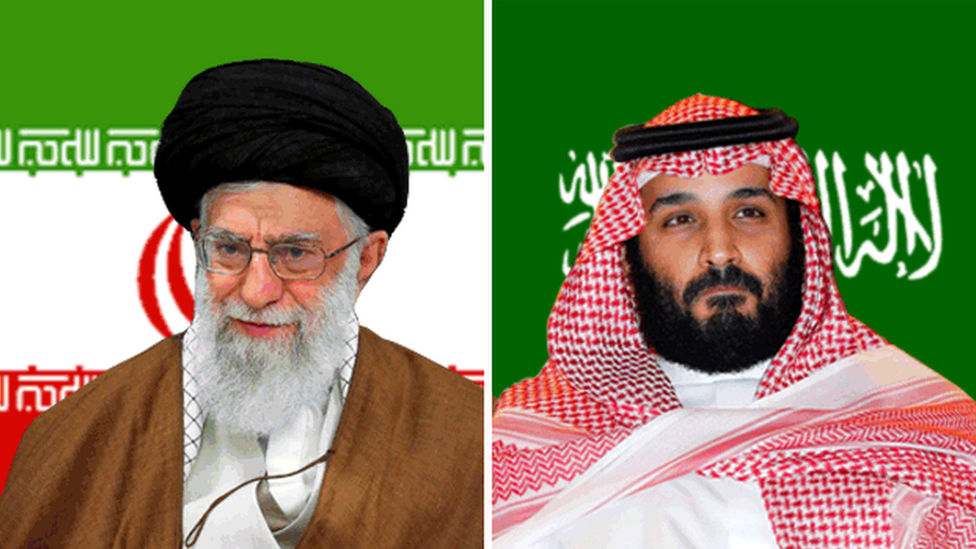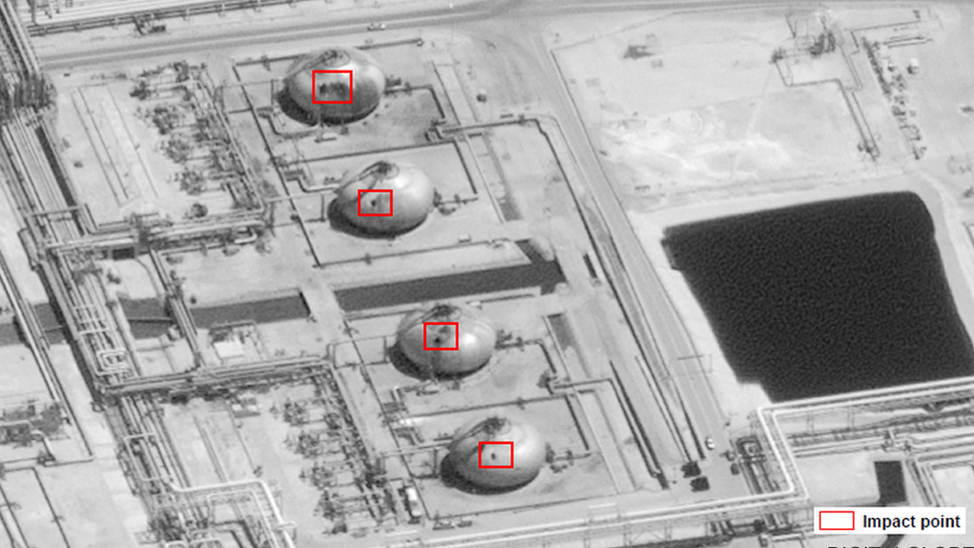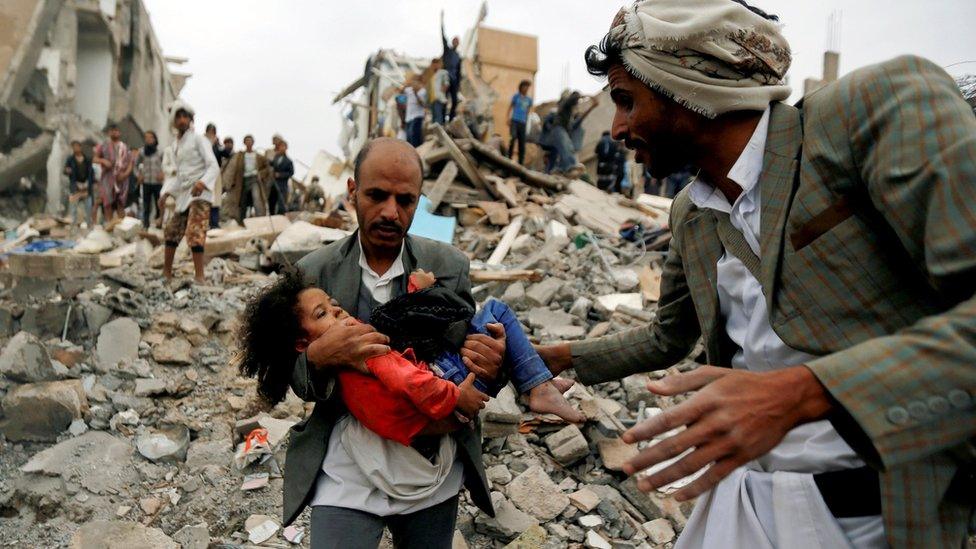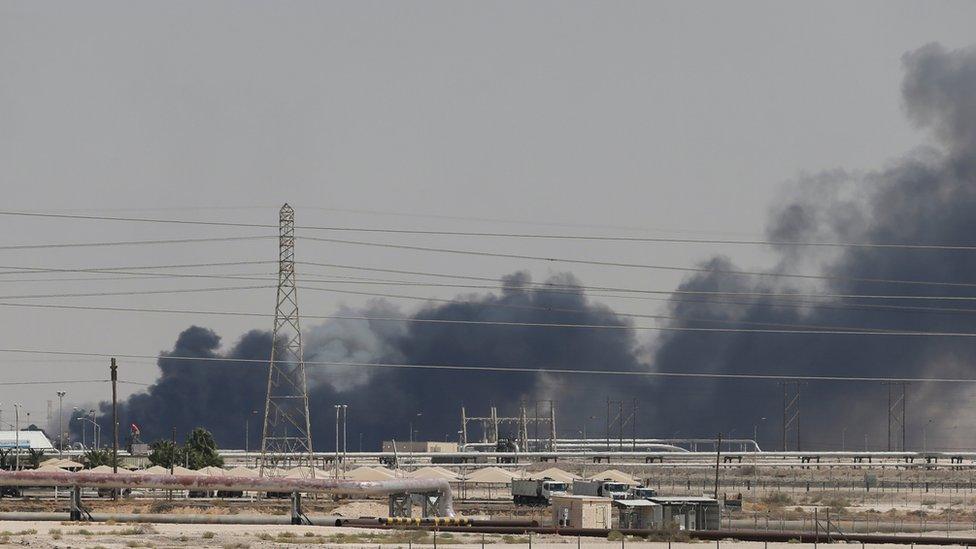Saudi oil attacks: Drones and missiles launched from Iran - US
- Published
Abqaiq has the world's largest oil processing plant
The US has reportedly identified locations in Iran from which drones and cruise missiles were launched against major Saudi oil facilities on Saturday.
Senior US officials told media outlets that the locations were in southern Iran, at the northern end of the Gulf.
Saudi air defences did not stop the drones and missiles because they were pointed southwards, to prevent attacks from Yemen, they added.
Iran denies involvement in the attacks, which disrupted global oil supplies.
Yemen's Iran-aligned Houthi rebels said they had launched the drones that struck the Abqaiq oil processing plant, the world's largest, and the Khurais oilfield.
They have launched attacks into Saudi Arabia before, but US officials said on Sunday they believed the drones and missiles did not originate from the south or south-west, and instead were launched from the north or north-west.
Iranian President Hassan Rouhani has called the attack a reciprocal act by the "Yemeni people".
Oil prices soared 20% after the attacks, at one point reaching $71.95 (£57.53) a barrel. But they have since pared their gains as it appeared market disruption would not be as bad as feared.
On Tuesday, Saudi Arabia's energy minister said he expected production to be fully back online by the end of the month, adding that half the production at the damaged facilities had already been restored.
Brent crude - the international benchmark used by traders - was trading at about $64 (£51.20) after the announcement.
What has the US said?
A senior US official told CBS News that a US team had been on the ground at Abqaiq, external and identified specific drones and missiles used in the attacks.
This wreckage will be analysed and used to present "a very compelling forensic case" that Iran was responsible, the report says.
Vice-President Mike Pence said on Tuesday the US was "evaluating all the evidence", and that Secretary of State Mike Pompeo was en route to Saudi Arabia "to discuss our response".
He added: "The United States of America will take whatever action is necessary to defend our country, our troops, and our allies in the Gulf. You can count on it."

One of the US government's satellite images showing damage at the world's biggest oil-processing facility
Iranian Foreign Minister Javad Zarif tweeted that "Yemeni victims" were responsible for the attacks, external, saying that blaming Iran would not change the situation and saying the US was "in denial".
Ending the war was the "only solution for all," he added.
And in a televised address, Iran's Supreme Leader Ayatollah Ali Khamenei dismissed talks "at any level" with the US, saying any dialogue could only happen if the US "takes back its words and repents" after withdrawing from the Iran nuclear deal.
Earlier this year, President Trump unilaterally pulled the US out of the landmark agreement that had limited Iran's nuclear programme in exchange for the lifting of economic sanctions.
The president told reporters on Tuesday he was not ruling out meeting Mr Rouhani at UN, as has been previously suggested, but added that he would "prefer not meeting him".
He also said he would be willing to use the US strategic oil reserves if need be.
"I don't believe I need to, but if we want to use strategic oil reserves, I would open them up," he said.
UK Prime Minister Boris Johnson meanwhile has condemned the attacks and spoken of his support for Saudi Arabia, telling Crown Prince Mohammed bin Salman there was a need to "establish the facts of what happened" and reiterating "the importance of a collective response", a spokeswoman said.


This is the strongest claim yet from the Americans that the attacks against the Saudi oil facilities were launched from Iran itself.
No corroborating evidence or intelligence has yet been provided. But if true, it takes the Gulf crisis to a more dangerous level and it demonstrates a new threshold of brinkmanship by the Iranian authorities. It also raises the question: what response, if any, is required?
For past US presidents the security of oil supplies in the Gulf was an absolute priority. But for the "locked and loaded" Donald Trump, for all his bluster and apparent affinity with the Saudi royal family, this is not necessarily the case. There is no treaty relationship between Washington and Riyadh, and the Saudis are increasingly unpopular on Capitol Hill.
The arguments for a response run both ways. If Iran's alleged escalation is not met by firm action, it might only embolden Tehran to go further. But the attacks have demonstrated Saudi Arabia's extraordinary vulnerability. In any protracted conflict it would be very much in the line of fire.
For the White House this is a strategic dilemma with no easy answers.

What happened in the attacks?
The attacks targeted Abqaiq - run by the Saudi state oil company, Aramco - and the Khurais oilfield.
Khurais is the closest of the targets to the Yemen border, but is still a considerable 770km (480 miles) away.

US officials said there were 19 points of impact on the targets, which could have come from a mix of drones and cruise missiles.
The Houthis have repeatedly launched rockets, missiles and drones at populated areas in Saudi Arabia, attacks which have left at least four civilians dead.
The conflict in Yemen escalated in March 2015, when the Houthis took control of much of the west of the country and forced President Abdrabbuh Mansour Hadi to flee abroad.
Soon after, Saudi Arabia and its allies launched an air campaign in a bid to restore Mr Hadi's government.
The UN says at least 7,290 civilians have died and 80% of the population - 24 million people - need humanitarian assistance or protection, including 10 million who rely on food aid to survive.


- Published16 September 2019

- Published16 September 2019

- Published16 September 2019

- Published13 June 2018

- Published14 September 2019
